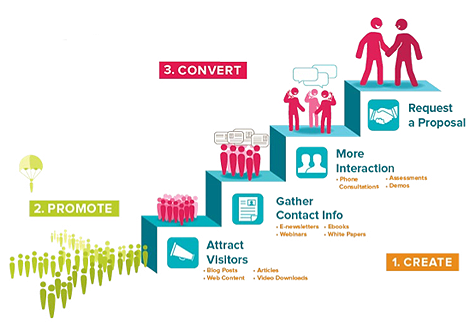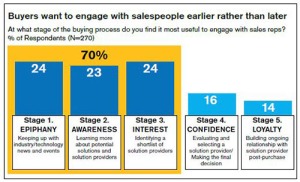The buyer’s journey is changing sales models and how B2B sales teams sell. Sales 2.0 as a sales technique has been around nearly ten years now but still many companies struggle to embrace it. If you are in B2B sales then Forester projects that over the next four years, 1 million B2B sales people will be replaced by self-service e-commerce. Those that want to have a long term career in sales will have to up-skill and move away from transactional selling while companies will have toembrace a sales model along with sales processes that adds value to the buyer’s journey.
One Million US B2B Salespeople Will Lose Their Jobs to Self-Service e-commerce by 2020
The reality is (and numerous research proves it) that increasingly B2B buyers prefer to research solutions online plus then conclude the cycle by buying the products and services via the web. How many companies still insist buyers to engage with their sales teams as part of the buying process? Maybe it’s time for sales leaders to transform the historical sales models, one which facilitates a highly social, seamless buying environment where maybe the website and not the sales teams are at the heart of how companies procure and sell.
So are B2B sales dying? Absolutely not but it does mean we have to recalibrate our view of the sales process and what it means to be a sales professional. The sales funnel is no longer being calibrated and decided by sales as the buyers decides where they are in the process. The good news is that a company’s potential customer base is bigger than ever, thanks to social media, the web and accessibility of communication paths to buyers.
Sales needs to rethink where and how to add value in the buying process, when and with what should sales people engage with the buyer so it improves the buyers journey are critical questions coming down the line. The old sales methodologies of marketing bringing in leads for the sales funnel where sales would then commence the process to qualify prospects based on some internal criteria to narrow down the focus to the most likely to convert to customers is disappearing.
It just does not work like that any more. Buyers are not travelling a journey prescribed in some sales manual or CRM system; they are taking their own journey and leaving sales models in the rear view mirror. But the key message for sales here is NOT about catching up (more sales training anyone) with the buyer’s journey but where along the road can we add value. It is about the buyer needing information, resources, guidance, advice and help depending where they are on the journey,
Below are some suggestions on what it will take to be successful in sales for the road ahead and to add value to the buyer in their journey
CONTENT TIMING IS VITAL AS BUYERS MOVE ALONG THE ROAD.
According to the Content Marketing Institute, 80% of decision makers prefer to get company information in a series of articles versus advertisements
A recent report from Forrester showed that over 33% of B2B marketers acknowledge that their biggest problem is figuring out how to deliver relevant content to specific buyers when the time is right. I recently wrote about “How to Use Content Marketing the ACD way” which may be worth reading.
IF OVER 66% OF THE BUYER’S JOURNEY IS DIGITAL, MAKE SURE YOU ARE WELL ROAD SIGNED.
If you read up on new sales methodologies or social selling, you have probably read that 67% of the buyer’s journey happens before sales ever get involved. Well this does not have to come true. Yes buyers are doing research online before contacting sales, so smart sales teams should position themselves as helpful signs or stopping of points along the way. Social selling, credible social presence, inviting and quality (even personalised) content will help flag you to buyer’s as they travel in search of solutions.
BUYERS TRUST OTHER TRAVELLERS ALONG THE JOURNEY, SO SALES CANNOT BE STRANGERS HITCHING A LIFT AT THE SIDE OF THE ROAD.
Research shows that only approx. nine percent of B2B buyers trust vendor content especially when it comes to data and claims. So they look for independent signs and also they trust information that comes from people they trust: valued social influencers, social network connections, ex-colleagues and friends. Sales has to work hard to get trust by offering valued contributions, staying in touch with existing buyers and sharing information that helps even when it’s not your own. Avoid the big neon signs about special offers, free coffee for everyone and buy today. Seek first to understand (where is the buyer on the journey) and then let the buyer be understood (what do they expect). A socially engaged sales mentality is a must.
INVITING THE BUYER IN WITH GENUINE HOSPITALITY WILL BE THE MOST PRODUCTIVE.
This is not an outbound V inbound argument, outbound sales will always have a place, it’s just about deciding where to place it! Day was when only cold calling and mass broadcasting was the only way for companies to talk to buyers. Sales 2.0 along with social media have flipped this on its head. In an Aberdeen Group report, they found that on average, the most successful sales firms got sixty percent of marketing leads from outbound marketing, while forty percent came through inbound efforts. However the inbound leads converted at a higher rate. The lesson here is these firms used content and not sales pitches to invite the buyer in regardless of whether outbound or inbound. Be a trusted, helpful resource to the buyer along the journey and not interrupting them is the way to get the attention of buyers.
SALES AND MARKETING ALIGNMENT
Finally, one last thought. On the buyer’s journey, sales, marketing and customer service are seen as a single entity. The term “Smarketing” has been thrown into the mix as a means to convey that sales, marketing and customer service have to collaborate more closely. All departments working as one will create a deeper understanding of the journey a customer takes to engage with your company.
In the socially connected, social media business world, everything moves at a faster pace and this is driven by the buyer. Any business that hopes to get the attention of the traffic on buyers road then they must understand where the potential buyers are coming from, what they demand along the way, and be wherever they need you to be with the right service.



No comments:
Post a Comment